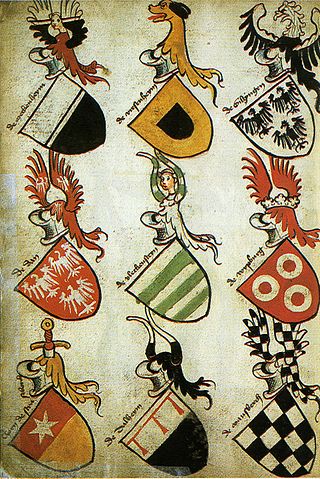
Heraldry is a discipline relating to the design, display and study of armorial bearings, as well as related disciplines, such as vexillology, together with the study of ceremony, rank and pedigree. Armory, the best-known branch of heraldry, concerns the design and transmission of the heraldic achievement. The achievement, or armorial bearings usually includes a coat of arms on a shield, helmet and crest, together with any accompanying devices, such as supporters, badges, heraldic banners and mottoes.
In heraldry, gules is the tincture with the colour red. It is one of the class of five dark tinctures called "colours", the others being azure (blue), sable (black), vert (green) and purpure (purple).

The coat of arms of the Philippines features the eight-rayed sun of the Philippines with each ray representing the eight provinces which were placed under martial law by Governor-General Ramón Blanco Sr. during the Philippine Revolution, and the three five-pointed stars representing the three major island groups of Luzon, the Visayas, and Mindanao.

The coat of arms of Anguilla is the heraldic device consisting of a shield charged with three orange dolphins leaping over the sea. Adopted in 1990, it has been the coat of arms of Anguilla since that year. The escutcheon is featured on the flag of the territory.
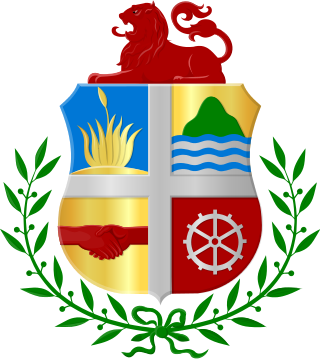
The Coat of arms of Aruba has been officially in use since November 15, 1955, as the recognized national symbol of Aruba.

In heraldry, cadency is any systematic way to distinguish arms displayed by descendants of the holder of a coat of arms when those family members have not been granted arms in their own right. Cadency is necessary in heraldic systems in which a given design may be owned by only one person at any time, generally the head of the senior line of a particular family.

The coat of arms of Romania was adopted in the Romanian Parliament on 10 September 1992 as a representative coat of arms for Romania. The current coat of arms is based on the lesser coat of arms of interwar Kingdom of Romania, which was designed in 1921 by the Transylvanian Hungarian heraldist József Sebestyén from Cluj, at the request of King Ferdinand I of Romania, it was redesigned by Victor Dima. As a central element, it shows a golden aquila holding a cross in its beak, and a mace and a sword in its claws. It also consists of the three colors which represent the colors of the national flag. The coat of arms was augmented on 11 July 2016 to add a representation of the Steel Crown of Romania.
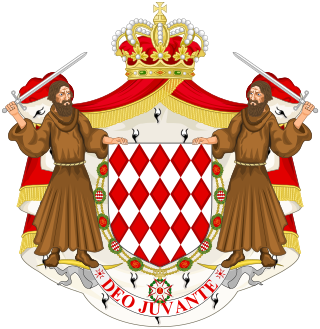
The coat of arms of Monaco, referred to also as an armorial achievement or an arms of dominion, is the symbolic representation of the House of Grimaldi, the current sovereigns of the principality of Monaco.
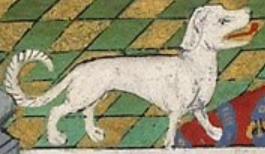
The Talbot was a type of hunting hound common in England during the Middle Ages. It is depicted in art of the period as small to medium-sized, white in colour, with short legs, large powerful feet, a deep chest with a slender waist, long drooping ears, and a very long curled tail. It is shown in one well-known example at Haddon Hall with a fierce facial expression. It is now extinct, but is believed to be an ancestor of the modern Beagle and Bloodhound. It is uncertain whether it was a scenthound, a sighthound, or a dog used for digging out quarry, nor is it known what type of quarry it hunted, whether deer, fox, boar, etc.

The coat of arms of Denmark has a lesser and a greater version.

The coat of arms of Portugal is the main heraldic insignia of Portugal. The present model was officially adopted on 30 June 1911, along with the present model of the Flag of Portugal. It is based on the coat of arms used by the Kingdom of Portugal since the Middle Ages. The coat of arms of Portugal is popularly referred as the Quinas.

Portuguese heraldry encompasses the modern and historic traditions of heraldry in Portugal and the Portuguese Empire. Portuguese heraldry is part of the larger Iberian tradition of heraldry, one of the major schools of heraldic tradition, and grants coats of arms to individuals, cities, Portuguese colonies, and other institutions. Heraldry has been practiced in Portugal at least since the 12th century, however it only became standardized and popularized in the 16th century, during the reign of King Manuel I of Portugal, who created the first heraldic ordinances in the country. Like in other Iberian heraldic traditions, the use of quartering and augmentations of honor is highly representative of Portuguese heraldry, but unlike in any other Iberian traditions, the use of heraldic crests is highly popular.

In heraldry and heraldic vexillology, a blazon is a formal description of a coat of arms, flag or similar emblem, from which the reader can reconstruct the appropriate image. The verb to blazon means to create such a description. The visual depiction of a coat of arms or flag has traditionally had considerable latitude in design, but a verbal blazon specifies the essentially distinctive elements. A coat of arms or flag is therefore primarily defined not by a picture but rather by the wording of its blazon. Blazon is also the specialized language in which a blazon is written, and, as a verb, the act of writing such a description. Blazonry is the art, craft or practice of creating a blazon. The language employed in blazonry has its own vocabulary, grammar and syntax, which becomes essential for comprehension when blazoning a complex coat of arms.

In heraldry, the term attitude describes the position in which a figure is emblazoned as a charge, a supporter, or as a crest. The attitude of a heraldic figure always precedes any reference to the tincture of the figure and its parts. Some attitudes apply only to predatory beasts, exemplified by the beast most usual to heraldry – the heraldic lion; other terms apply to docile animals, such as the doe, usually emblazoned as a "hind".

The Penn Quakers are the athletic teams of the University of Pennsylvania. The school sponsors 33 varsity sports. The school has won three NCAA national championships in men's fencing and one in women's fencing.

German heraldry is the tradition and style of heraldic achievements in Germany and the Holy Roman Empire, including national and civic arms, noble and burgher arms, ecclesiastical heraldry, heraldic displays and heraldic descriptions. German heraldic style is one of the four major broad traditions within European heraldry and stands in contrast to Gallo-British, Latin and Eastern heraldry, and strongly influenced the styles and customs of heraldry in the Nordic countries, which developed comparatively late. Together, German and Nordic heraldry are often referred to as German-Nordic heraldry.
Meiklejohn Stadium is a ballpark in Philadelphia, Pennsylvania. It is on the University of Pennsylvania campus and is the home field for the University of Pennsylvania Quakers varsity baseball team. It opened in March 2000.
Cornish heraldry is the form of coats of arms and other heraldic bearings and insignia used in Cornwall, United Kingdom. While similar to English, Scottish and Welsh heraldry, Cornish heraldry has its own distinctive features. Cornish heraldry typically makes use of the tinctures sable (black) and or (gold), and also uses certain creatures like Cornish choughs. It also uses the Cornish language extensively for mottoes and canting arms.

The name Roosevelt is an American toponymic surname derived from the Dutch surname Van Rose(n)velt, meaning "from rose field" or "of a rose field." The most famous bearers of this name come from the Roosevelt family, a merchant and political family descended from the 17th-century immigrant to New Netherland Claes Maartenszen van Rosenvelt.
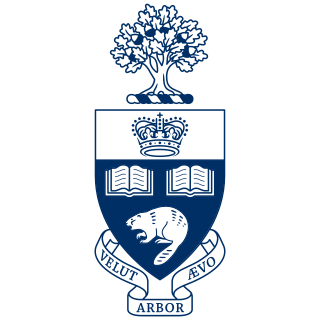
The coat of arms of the University of Toronto is the primary emblem of the University of Toronto, which is the largest university in Canada. It is currently used in several different contexts by the University and can be seen on its own, on the University banner, as part of the heraldic achievement of the University, or featured in the logos of numerous University divisions, as well as the logo of the University as a whole.



















